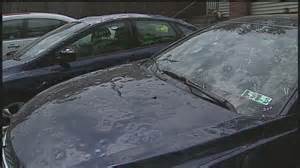Spring Weather Brings Extreme Increase in Hail Damage to Cars
 |
Nearly 70 percent of all hail-related claims happen in Q2, according to Farmers Insurance
LOS ANGELES -- May 20, 2015: Hail is the leading cause of non-collision auto claims during the spring, but consumers can take steps to better protect their vehicles, according to the latest Farmers Seasonal Smarts Digest from Farmers Insurance.
Nearly 70 percent of all hail-related claims among Farmers Insurance customers for 2013 and 2014 were filed in April, May or June, with states in the Midwest and Southwest reporting the highest amounts of damage. For Oklahoma, around 90 percent of the annual number of non-collision claims were filed during the second quarter showing that hail and damage from tornadoes played a significant role in auto damage over those two years.
"The average hail storm lasts just six minutes, but the damage it can cause to a vehicle can be severe," said Paul Quinn, head of claims customer experience at Farmers. "Springtime is a time for extra caution, especially in the Midwest. In hail-prone states, drivers can benefit greatly by taking a few proactive steps to avoid the headache that comes with getting your car caught in a hail storm."
To protect their vehicles from hail, consumers should consider the following, Quinn said:
Stay where you are. If you know a storm is coming, sometimes the best place to be is right where you are. This is especially true if the severe weather is expected to hit along your route. Get covered parking. Garages and carports are the best places to store vehicles in the spring because a hail storm could happen anytime. When possible, park in locations where your car will be covered. Seek shelter. Drivers should move their cars to a covered area if a hail storm hits. This may mean staying home or finding a nearby shopping area with covered parking options. This should never mean stopping under a bridge or overpass. Hail is frequently involved in storm systems that spawn tornadoes and a bridge or overpass is the worst place to be during a tornado. Use hail blankets or a car cover. Drivers can purchase a car cover or place specialized hail blankets on top of the vehicle if covered parking is unavailable. Make sure all coverings are secure, as the wind associated with hail storms can blow loose covers away. Most importantly, drivers should contact their insurance agent to ensure their auto insurance policies have adequate coverage in case their vehicle is damaged by hail.
"The best time for drivers to find out whether they're covered for hail damage is before a storm," Quinn said. "Customers should take the time to make sure their coverage is sufficient for any possible scenario by meeting with their insurance agent to discuss any questions."
The complete Farmers Seasonal Smarts Digest detailing the spring's most common hazards, as well as safety and preparedness tips to help keep drivers and their cars safe, can be found online at Inner Circle.


